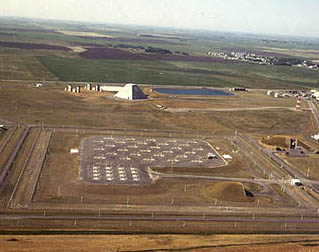|
ABM at Grand Forks
|
1962 - USSR began development of the world's first anti-ballistic missile system to defend Leningrad from an ICBM attack. In 1964, a second center was built to defend Moscow with the Galosh missile. However, by 1969 only 4 of the planned 8 centers were completed, each with 16 nuclear-armed Galosh missiles. The missiles were guided by a radar system of large A-frame "Dog House" radars and similar "Cat House" radars, with a network of early warning "Hen House" radars on the country's northwest border called the Tallinn Line.
1967 - The US began development of the Sentinel ABM system when Robert McNamara announced plans for the system Sept. 18 due to the recent development of Chinese atomic weapons. The Sentinel would use Spartan and Sprint missiles developed since 1964 by Martin Marietta from the Nike missile. The Perimeter Acquisition Radar (PAR) and Missile Acquisition Radar (MAR) systems were developed by General Electric in 1969 to provide early detection and guidance.
1969 - In January, Senator Edward Kennedy led opposition in Boston to the construction of a nuclear Sentinel site NEAR THE CITY. On March 14, Nixon replaced the Sentinel program with Safeguard that included only 12 sites. Despite much public opposition, the program passed Congress Aug. 6 with VP Agnew casting the tie-breaking vote. The first 2 sites at Malmstrom AFB in Montana and Grand Forks AFB in North Dakota would protect Minutemen ICBM missile silos. The beginning of SALT negotiations in December included limiting ABM systems.
1970 - The US planned to add 2 more Safeguard sites at Whiteman AFB in Missouri and Warren AFB in Wyoming.
1972 - The USSR and US signed the ABM Treaty limiting each country to 2 ABM sites and a total of 200 missiles.
1975 - The ABM site at Nekoma 100 miles northwest of Grand Forks became fully operational October 1 with 70 Sprint and 30 Spartan missiles. It was known as the Stanley R. Mickelson complex and defended 150 Minuteman silos in the area. However, Congress voted October 2 to dismantle to the site by Feb. 1976. It was operational for only five months.
1978 - The USSR improved its ABM system with Pillbox phased-array radar at Pushinko and improved Galosh missiles for long-range interception, and high-acceleration Gazelle missiles for short range interception. The new system of 200 missiles protected only Moscow and complied with the 1972 treaty.
Links:
- Nuclear ABMs of the USA Nuclear Weapons Cost from Brookings Institute includes ABM and photos
- Military Missiles webring Strategic Air & Space Museum for SAC in Nebraska
- Titan II ICBM Web Page by Donald Boelling
- National Museum of the United States Air Force near Dayton, Ohio
